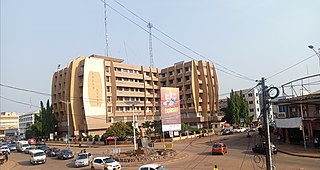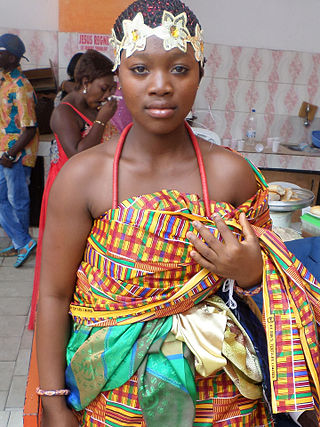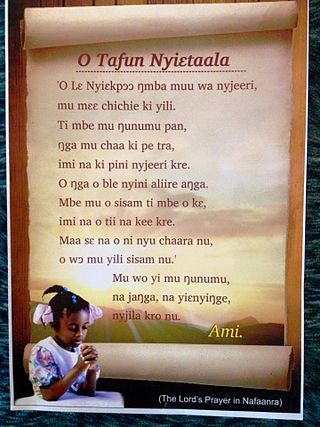
The regions of Ghana are the first level of subnational government administration within the Republic of Ghana. As of 2020, there are 16 regions, which are further divided for administrative purposes into 260 local metropolitan, municipal and district assemblies.

The Brong-Ahafo region was a region in central Ghana. Brong-Ahafo was bordered to the north by the Black Volta river and to the east by the Lake Volta, and to the south by the Ashanti, Eastern and Western regions. The capital of Brong-Ahafo is Sunyani. Brong-Ahafo was created on 14 April 1959 from the then Western Ashanti and named after the main ethnic groups, the Brong and Ahafo. In 2019, as a result of the 2018 Ghanaian new regions referendum, the region was divided into three, namely Bono, Bono East and Ahafo regions, and ceased to exist.
Sampa is a town in the Bono Region of Ghana, on the border with Côte d'Ivoire. It is the capital of Jaman North District and was formerly the site of a slave market. It was also the capital of the Akan State of Gyaaman in the late 15th century. It is the largest border town in Ghana with a population of over 36,000. It is the principal town of the Nafana ethnic group. It is the leading producer of cashews in Ghana.
The Akan people are a Kwa group living primarily in present-day Ghana and in parts of Ivory Coast and Togo in West Africa. The Akan speak languages within the Central Tano branch of the Potou–Tano subfamily of the Niger–Congo family. Subgroups of the Akan people include: the Agona, Akuapem, Akwamu, Akyem, Anyi, Ashanti, Baoulé, Bono, Chakosi, Fante, Kwahu, Sefwi, Wassa, Ahanta, Denkyira and Nzema, among others. The Akan subgroups all have cultural attributes in common; most notably the tracing of royal matrilineal descent in the inheritance of property, and for succession to high political office. All Akans are considered royals in status, but not all are in royal succession or hold titles.
Bono State was a trading state created by the Bono people, located in what is now southern Ghana. Bonoman was a medieval Akan state that stretched across the modern Ghanaian regions of Bono, Bono East and Ahafo and the Eastern Ivory Coast. It is generally accepted as the origin of the subgroups of the Akan people who migrated out of the state at various times to create new Akan states in search of gold. The gold trade, which started to boom in Bonoman as early as the 14th century, led to the Akan War, as well as increased power and wealth in the region, beginning in the Middle Ages.

Sunyani is a city and the capital of the Sunyani Municipal District and the Bono Region of Ghana. The city is located about 105 miles (169 km) southwest of Kumasi and 300 miles (480 km) away from Accra. It is the sixth largest city in the country as of the 2010 census, with a population of 75,366 people. Ethnic groups such as the Akan, Northerner, Ewe, and Ga-Adangbe resided in the city along with others. As of 2024, the current mayor of the municipality is Hon. Ansu Kumi.

The Bono, also called the Brong and the Abron, are an Akan people of West Africa. Bonos are normally tagged Akan piesie or Akandifo of which Akan is a derivative name. Bono is the genesis and cradle of Akans. Bono is one of the largest ethnic group of Akan and are matrilineal people. Bono people speak the Bono Twi. The name Twi is a derivative of a Bono King Nana Twi
Nkoranza is a town located in the mid-north of Ghana. It is the district capital of the Nkoranza District in the Bono East Region.
The Apoo Festival is a festival celebrated annually in western Ghana, lasting a week in March and April. The festival is meant to ritually purify the people of social evils, as well as uniting people and families, and includes a variety of other traditional cultural activities. The word 'apoo' comes from the root word 'po', meaning 'to reject.'

Wenchi is a town and the capital of Wenchi Municipal of the Bono Region in the middle-belt of Ghana. Wenchi is located at 7.73333 [latitude in decimal degrees], -2.1 [longitude in decimal degrees] at an average elevation/altitude of 304 meters. Wenchi is approximately 30 km north of Techiman and about 50 km east of the Ivory Coast border. Wenchi has a population of 39,187 people in 2013.
Brong Ahafo United is a Ghanaian football Club, based in Sunyani, currently competing in the Ghana Premier League. It was established in 1960 to bring the people of Bono or Brong and Ahafo together through football. The club is also known as Apostles of power soccer. Their long time regional rival is Bofoakwa Tano, a club based in Sunyani as well. Other known clubs in the region are Aduana Stars(two time GPL champions), Berekum Chelsea, Young Apostles(BA United seed), DC United, Nsoatreman, Wamnafo might Royals, and few other clubs not mentioned.
Duayaw Nkwanta is a town and the capital of Tano North Municipal District, a municipal in the Ahafo Region of Ghana. It is located close to Sunyani, the capital of Bono Region. The infrastructure of Duayaw Nkwanta is well structured. Duayaw Nkwanta has a settlement population of 27,476. This town boast of good schools such as: Boakye Tromo Senior High Technical School, Serwaa Kesse Girls Senior High School, Presbyterian Midwifery Training College among others.
Fiapre is a town in Sunyani West Municipal in the Bono Region of Ghana. Fiapre is very close to the regional capital town of the Bono Region, Sunyani.

Banda Ahenkro is a town located in the west-northern of Bono region, Ghana, near the border of Ivory Coast. Its geography provided a home for numerous groups seeking shelter from across West Africa during the slave trade era. The original name of the settlement was Serminakuu meaning groups of 'grasses'. This name was changed to Banda, which is a corruption of 'Woanda' meaning 'they did not sleep'. Ancestors of Banda Ahenkro were allies of the Asante kingdom during wars and they provided a military force that virtually refused to sleep during at-war times. This is because they were predominantly Muslims and were found praying throughout the night. Later, 'woanda' was also corrupted by the Bono neighbours to become Banda. The settlement evolved to become the chief town or 'Ahenkro' within a collection of Nafana communities.

The Bono region is one of the 16 administrative regions of Ghana. It is as a result of the remainder of Brong-Ahafo region when Bono East region and Ahafo region were created. Sunyani, also known as the green city of Ghana, is the regional capital. Sunyani can pride itself as the cleanest capital city and a major conference destination.
Kwame Boahene Yeboah-Afari was an educator and a politician. He served in various ministerial portfolios of the first republic including serving as Ghana's first Minister for Agriculture and the first Regional Minister for the Brong Ahafo Region. He also served as a member of parliament for the Sunyani East constituency.

The Bono East region of Ghana is a new region carved out of the Brong Ahafo region. The capital of the new region is Techiman. This creation of this new region was in fulfillment of a promise made by the New Patriotic Party prior to the 2016 Ghana general election. Upon winning the elections, the President, Nana Akuffo Addo created the Ministry of Regional Reorganization to oversee policy formulation and implementation. In all six new regions are to be created from the existing ten regions of Ghana. The other regions are Ahafo, Western North, Savannah, North East, and Oti regions.
Grace Boachie is a Ghanaian politician and a member of the second Parliament of the Fourth Republic representing the Tano South Constituency in the Brong Ahafo region of Ghana.
Tanoboase Sacred Grove and Shrine is near the village of Tanoboase in the Techiman, Brong Ahafo region of Ghana. It is believed to be the cradle and the traditional home of the Bono people. It is said by the Tanoboase people that powerful Ashanti Gods reside in the sacred grove. Historically the site is where Ashanti Wars were fought. The grove was a hideout during the slave trade and inter-tribal wars. The grove is also a place for religious activities.











